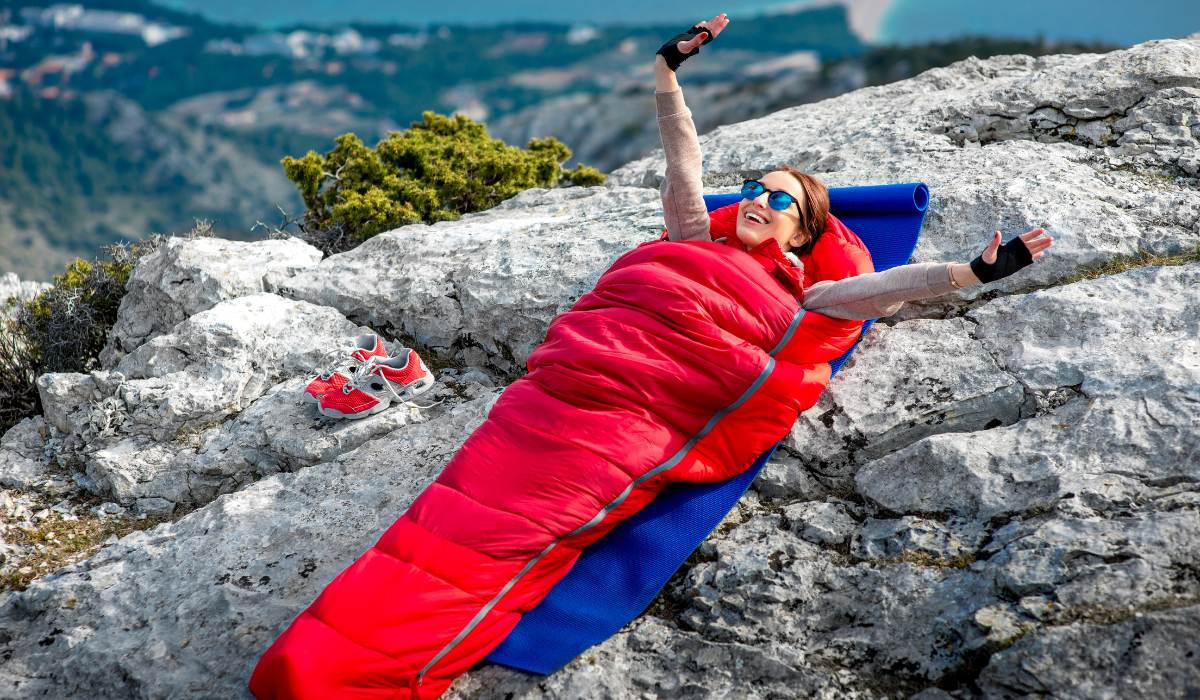Ah, the great outdoors! There’s nothing quite like swapping the confines of our daily routine for a night under the stars. But as any seasoned camper will tell you, the key to a great camping trip is preparation. And in the heart of this preparation lies the humble sleeping bag – often overlooked, yet pivotal to a good night’s sleep. Whether you’re a camping novice or a seasoned veteran, choosing the right sleeping bag can make or break your outdoor adventure. So, let’s dive into the world of sleeping bags, and help you find the cozy cocoon perfect for your next camping trip.
Why sleeping bag is important for travel?
A sleeping bag is akin to your very own portable bedroom when on the move. It’s more than just a blanket—it’s your shield against the cold, your cushion on hard ground, and your safe space when you’re far away from home under a canopy of stars. In fact, it’s one of the three “Biggies” of backpacking and camping gear (along with backpacks and tents). Without a good night’s sleep, your long-awaited adventure can become an ordeal, impairing your ability to enjoy the beautiful landscapes and exhilarating activities during the day. That’s why it’s essential to pick a sleeping bag that suits your needs, ensuring you wake up refreshed and ready to seize the day!
Types of Sleeping Bags for Travel
When it comes to sleeping bags, one size doesn’t fit all, which is why there are numerous types designed to cater to various needs, climates, body sizes, and personal preferences:
Firstly, we have the Mummy sleeping bags, shaped like an Egyptian sarcophagus and designed to hug your body tightly, preserving heat, and keeping you toasty on those chilly nights. These sleeping bags are meticulously crafted with contoured hoods and draft collars to minimize heat loss and maximize insulation. They are ideal for backpackers and adventurers who prioritize warmth and weight-saving features.

Then we have the Rectangular sleeping bags, providing ample space for those who love a good stretch in their sleep. These spacious sleeping bags are perfect for car camping, family camping trips, or indoor use. They offer more room to move around and are suitable for warmer climates where heat retention is not as critical.

For the minimalists and ultralight enthusiasts, there are Quilt sleeping bags. These innovative sleeping systems combine the simplicity of a blanket with the functionality of a sleeping bag. Quilt sleeping bags are lightweight, compact, and versatile, allowing you to regulate your body temperature by adjusting the level of coverage. They are a popular choice among thru-hikers and backpackers who prioritize freedom of movement and customizable insulation.

Lastly, for the ultimate comfort seekers, we’ve got Double sleeping bags. These spacious sleeping bags are designed to accommodate two people comfortably or afford a single sleeper an indulgent amount of space. Double sleeping bags are perfect for couples or solo campers who prefer a more roomy and luxurious sleeping arrangement. However, it’s worth noting that they tend to be bulkier and heavier compared to other types of sleeping bags.

Each type of sleeping bag comes with its own set of pros and cons, so it’s important to take into account your specific travel conditions, climate, and individual needs when making a choice. Whether you’re embarking on a mountaineering expedition, planning a family camping trip, or simply enjoying a weekend getaway, there’s a perfect sleeping bag out there to ensure you get a restful and comfortable night’s sleep.
Key factors to consider when selecting a sleeping bag for camping
No two campers are alike, and neither are their sleeping bag needs. So here are some factors to consider when choosing the perfect sleeping bag for your next outdoor trip:
- Temperature Rating: The most crucial element in choosing a sleeping bag is its temperature rating, which indicates the lowest temperature at which it will keep you warm. Consider the climate of your destination and the time of year you plan to camp, and choose between 3-season bags (above freezing), 4-season bags (below freezing), and extreme weather bags (sub-zero).
- Insulation Type: The material used for insulation is what keeps you warm, so select your preferred type based on weight, warmth, and cost. Common options include down feathers, synthetic fibers such as polyester and nylon, or a combination of both.
- Weight & Packability: Backpackers and hikers should opt for lightweight sleeping bags and those that pack down small, while car campers have the luxury of space to prioritize comfort over weight.
- Shape & Size: Consider your body shape, height, and preferred sleeping position when selecting a bag. A snug fit is essential for retaining heat in cold weather, but if you’re claustrophobic or a restless sleeper, go for wider bags.
- Features: Some additional features to consider include built-in pillows, draft collars and tubes, hood design, zippers (left- or right-handed), and ease of ventilation.
- Price & Warranty: As with most things in life, you get what you pay for with sleeping bags. If you’re a regular camper, investing in a high-quality bag that will last for years is a wise choice. Some manufacturers also offer long-term warranties to protect your investment.
Additional Features to Consider in Sleeping Bag
While a sleeping bag is undoubtedly the quintessential item for camping, there are other essential gear considerations that can greatly enhance your comfort for a restful night’s sleep in the great outdoors. These additional items include:
- Sleeping Pad/Inflatable Mattress: A quality sleeping pad or inflatable mattress not only provides insulation from the cold ground but also offers an extra layer of cushioning for optimal comfort. It ensures you wake up feeling refreshed and energized, ready to seize the day’s adventures.
- Pillow: For those who can’t bear the thought of sacrificing their beloved pillow, fear not! Inflatable or compressible pillows are the perfect solution for campers looking to pack light without compromising on comfort. These portable pillows offer the familiar support and coziness of home, ensuring a good night’s sleep under the stars.
- Sleeping Bag Liner: To further enhance your camping experience, consider adding a lightweight sleeping bag liner to your gear list. This thin layer of fabric not only adds an extra level of warmth on chilly nights but also helps maintain cleanliness and hygiene inside your sleeping bag. By keeping dirt and sweat away from your bag’s interior, it can prolong its lifespan and ensure a fresh sleeping environment.
- Compression Sack/Dry Bag: Organizing your camping gear is essential for a hassle-free outdoor adventure. A compression sack or dry bag proves invaluable in this regard. These versatile storage solutions not only help you efficiently pack and compress your sleeping bag, saving valuable space in your backpack, but also keep it dry and protected from moisture, ensuring a cozy and dry sleep even in wet conditions.
- Campsite Selection: Selecting the perfect campsite is crucial for an enjoyable camping experience. Opt for a sheltered location on flat ground, away from potential hazards like rocks, sticks, and debris. Avoid low-lying areas that may become waterlogged during rainfall. Additionally, be mindful of any potential risks, such as flooding or overhanging branches, that could compromise your safety. By carefully choosing your campsite, you can create a serene and secure environment to unwind and connect with nature.
By considering these additional gear options and taking the time to choose a suitable campsite, you can elevate your camping experience to new heights of comfort, ensuring a truly rejuvenating escape into the wilderness.
How to take care of your traveling Sleeping bags?
Taking proper care of your sleeping bag is crucial to ensure its longevity and continued warmth and comfort on countless trips. Here are some detailed tips to help you maintain your sleeping bag:
- Air out your sleeping bag: After returning from a trip, make it a habit to hang your sleeping bag up and allow it to thoroughly air out and completely dry before storing it away. This helps prevent any trapped moisture or odors from lingering.
- Store the bag correctly: It’s important to store your sleeping bag properly to prevent damage to the insulation. Instead of compressing or folding it for extended periods, opt to store it loosely in a large storage bag or hang it up. This helps maintain the loft and quality of the insulation over time.
- Spot clean when necessary: If you notice any soiled areas on your sleeping bag, it’s best to spot-clean them rather than washing the entire bag. Use a damp cloth and mild soap to gently clean the affected areas, ensuring they are completely dry before storing the bag.
- Wash only when needed: Washing your sleeping bag should be done sparingly and following the manufacturer’s instructions. When it’s time to wash, use a gentle cycle and mild detergent, and make sure to thoroughly dry the sleeping bag before storing it away. Proper drying is crucial to avoid any mold or mildew growth.
- Avoid extreme temperatures: It’s important to protect your sleeping bag from extreme temperatures that can potentially damage the insulation. Avoid direct sunlight or high heat sources, as they can cause the insulation to deteriorate. Additionally, steer clear of sleeping next to campfires or heaters, as sparks or embers could lead to burns or holes in the fabric.
- Protect from moisture: To safeguard your sleeping bag from moisture, consider using a groundsheet or tarp underneath it when camping. This provides an additional layer of protection and minimizes the risk of moisture seeping into the sleeping bag. It’s also advisable to avoid leaving your sleeping bag exposed to rain or damp conditions.
- Avoid using it as a mat: While your sleeping bag offers warmth and comfort, it’s not designed for durability. To prevent rips and tears, avoid using it as a mat or sitting directly on rough surfaces. Using a separate mat or pad will help protect your sleeping bag and extend its lifespan.
By keeping these detailed tips in mind, you can confidently choose the perfect sleeping bag for your camping adventures and ensure many restful nights under the stars. Happy camping!
Ready for the adventure?
In conclusion, selecting the right sleeping bag for camping involves more than just considering the bag itself. It’s also about the additional gear and care strategies that can enhance your experience and extend the longevity of your gear. From sleeping pads, compressible pillows, and sleeping bag liners, to storage solutions like compression sacks or dry bags, each component plays a crucial role. Choosing the perfect campsite and taking proper care of your sleeping bag is equally important. By considering all these factors, you can ensure a comfortable and rejuvenating camping experience, and keep your sleeping bag in optimal condition for many future adventures. Happy camping!











Leave a Reply